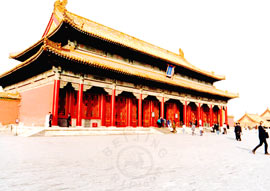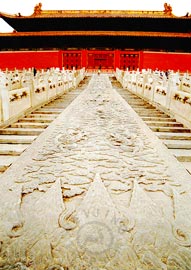 Hall of Preserving Harmony
Hall of Preserving Harmony
 The Hall of Preserving Harmony (Baohe Dian) is the last main hall in the Outer Court. Like the Hall of Supreme Harmony, this rectangular wooden hall has multiple eaves, with ten different animal statues at each corner. In ancient China, the number of different animals on a house was a sign of its rank. A group of ten animals is the maximum which is only seen on imperial palaces. The hall doesn't have many columns inside which makes it seem quite spacious.
The Hall of Preserving Harmony (Baohe Dian) is the last main hall in the Outer Court. Like the Hall of Supreme Harmony, this rectangular wooden hall has multiple eaves, with ten different animal statues at each corner. In ancient China, the number of different animals on a house was a sign of its rank. A group of ten animals is the maximum which is only seen on imperial palaces. The hall doesn't have many columns inside which makes it seem quite spacious.
The hall was used for different purposes as dynasties changed. In the Ming Dynasty (1368-1644), ceremonies were held here when the emperor made declarations, such as a new empress or crown prince. During the Qing Dynasty (1644-1911), feasts were given to nobles and ministers on special occasions, such as the Spring Festival (lunar January 1st), the Lantern Festival (lunar January 15) and princesses' wedding days. The candidates who had won a series of preliminary contests took the Final Imperial Examination at the hall. The Final Imperial Examination took place every three years and the topic for an essay was assigned by the emperor himself.

 Huge Stone Carving
Huge Stone Carving
When visiting the Outer Court, you may find stone carvings along the terrace leading to the halls. The one behind the Hall of Preserving Harmony is the largest one in the palace. This huge stone carving was sculpted of bluestone in the Ming Dynasty (1638-1644) and was carved anew in the Qing Dynasty (1644-1911). It is 16.57 meters (54.36 feet) long, 3.07 meters (10.07 feet) wide and 1.7 meters (5.6 feet) thick. No wonder it is weighs around 250 tons. This sculpture depicts nine dragons soaring into clouds and waves pounding cliffs.
This giant stone itself has an intriguing story. It was moved to the palace from the Fangshan District. This district is approximately 70 kilometers (43.5 miles) away and there is no waterway between it and downtown Beijing. The bulky stone was pulled the entire distance, by 20,000 laborers. Along the way wells were dug every 0.5 kilometer (0.31 mile), to provide drinking water for the laborers. On very cold days, water was poured on the roads to make them icy, so that the stone could be towed more easily. It took twenty-eight days to accomplish such a difficult task!
 Go to the Next Attractions: Gate of Heavenly Purity & Hall of Heavenly Purity
Go to the Next Attractions: Gate of Heavenly Purity & Hall of Heavenly Purity